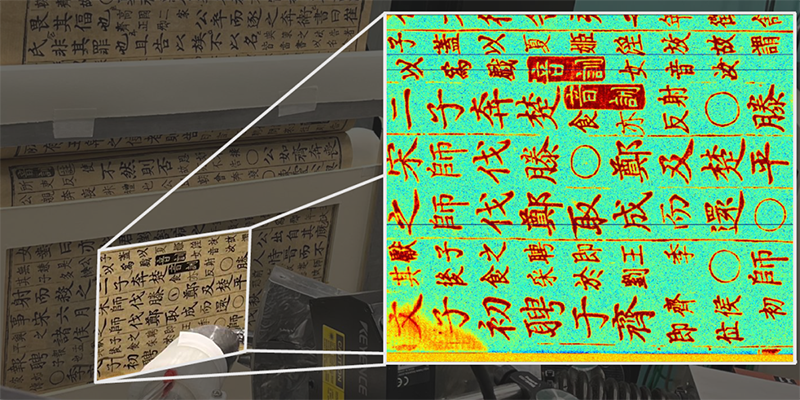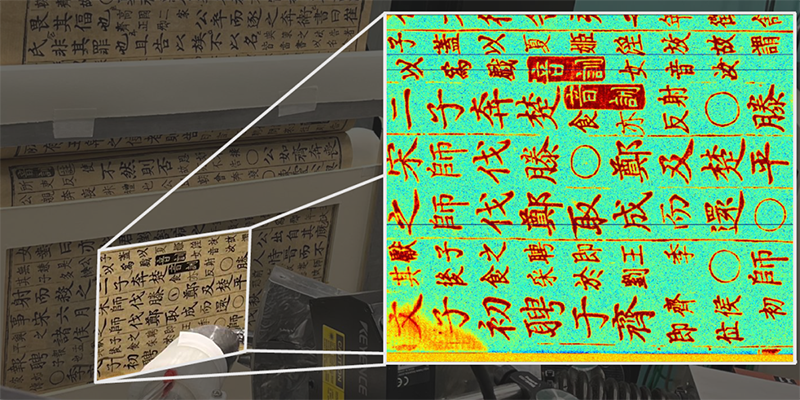The History of the Printing Press under an X-Ray Microscope
The printing press has been called the greatest invention of the last thousand years. The credit is often given to the 15th century German craftsman Johannes Gutenberg. However, a Korean collection of Buddhist teachings, the Jikji Simchi Yojeol, was printed with a press 78 years before Gutenberg produced his first Bible. What are the similarities and differences in the methods employed for printing the Jikji and the Gutenberg Bible? As part of a collaborative research project, researchers are addressing this question using an x-ray probe at SLAC National Accelerator Laboratory in California. What they learn about the chemical composition of ancient Eastern and Western texts will provide insight into how knowledge sharing between cultures shaped the technological evolution of printing.
The history of printing goes further back than both the Jikji and the Gutenberg Bible. Archaeological evidence from the 8th century shows that East Asian scribes carved images of text onto wooden blocks, rubbed ink onto them, and pressed the inky text onto paper—creating the first printed scrolls. That technique eventually shifted to what’s now known as movable metal type printing. Here, a craftsman poured molten metal into moulds to create collections of hardened metal type. These character “stamps” were then arranged on a board into a text that could be dipped in ink and imprinted on a page.
The process may sound straightforward to us, but artisans at the time faced many challenges, such as finding the best metal composition and optimizing the typesetting technique. Historical research by the UNESCO International Centre for Documentary Heritage (ICDH) in Korea has shown that Korean scribes had mastered these issues sufficiently to print books with movable metal type as early as the year 1234. The oldest known example of this printing tradition is a copy of the Jikji from 1377.
Yet Gutenberg remains widely considered as the inventor of movable metal type printing. The record is slowly being set straight, though. Recent discoveries of movable metal type pieces from Korea have confirmed a pre-Gutenberg printing industry. And this summer, the French National Library recognized Korea’s role as the birthplace of printing with an exposition that displayed the oldest printed Jikji alongside Gutenberg prints
The history of printing is being rewritten, but there are still many mysteries about early movable metal type prints in both the East and the West. “The million-dollar question is, did Gutenberg know about the Korean technology or not?” says Uwe Bergmann, a physicist at the University of Wisconsin-Madison, who has developed and applied x-ray spectroscopy methods at SLAC’s Stanford Synchrotron Radiation Lightsource (SSRL) for many years. It’s unlikely that researchers will be able to pinpoint Gutenberg’s influences, but examining the chemical composition of materials in samples from both printing cultures will help researchers to piece together their precise methods and possible connections. Bergmann and his colleagues are collecting this chemical information using high-resolution x-ray fluorescence (XRF) imaging of ancient texts.
The researchers gather their data by placing pages in an x-ray beamline at SSRL, specially designed for examining large and fragile samples in archaeological, medical, and geological studies. The beam scans across an individual page, stopping at each pixel to collect an XRF spectrum that can reveal the chemical elements in the paper and the ink. “When we started XRF imaging at SSRL many years ago, we could only measure ten [chemical] channels for each pixel. Now we can collect the whole XRF spectrum with over 2000 channels at each pixel,” says Bergmann. For printed manuscripts, the result is an up-to-5-megapixel x-ray image of a single page obtained in just a few hours.
During 2022, Bergmann and his colleagues analyzed pages from tens of examples of pre-1500 Korean and Gutenberg texts. The researchers were surprised that both sets of prints contained relatively large amounts of metals in their inks, including copper and lead. “We are trying to understand if these observed metal signals are related to the metal types used for the printing,” says Angelica Noh, a member of the team from ICDH.
To explore this possible relation, the researchers are replicating early printing techniques using different inks and different papers. This “historical reenactment”—which Bergman described in a talk at the Canadian Society for Chemistry meeting this summer—offers an opportunity to compare the fine-scale chemical details in recreated pages to those in the historical versions. “Our initial studies on self-made prints are exploring if and to what extent metals from the types might leach out into the print,” Bergmann says. They are also examining other possibilities, such as the metals being added to the ink as a drying agent.
Although the project is still in its early stages, the hope is that the research will fill in gaps in our understanding of the earliest printing methods. In particular, not much is known about the types of materials used in medieval European printing. “If we can confirm that the metals are leaching into the ink, we might be able to use that information to learn more about the alloy for the types used by Gutenberg and other early Western prints,” Bergmann says. That alloy information could then be compared to what is known about Korean metal types, many of which still exist. Possible similarities could be evidence of technology transfer between the East and the West.
Whatever the exact history, movable metal type printing has had an indelible mark on human civilization. As part of a UNESCO heritage anniversary of the Jikji, Bergmann and his colleagues are preparing a multicountry exhibit for 2027. “We want to inform the world about the beginning of this technology,” he says.
–Rachel Berkowitz
Rachel Berkowitz is a Corresponding Editor for Physics Magazine based in Vancouver, Canada.





